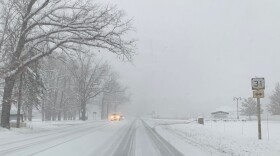Cary Godwin has spent this summer training a group of 10 cadets at the Great Lakes Maritime Academy to sail a tugboat.
During the last week of class this month, he leaned back and watched as his students navigated a vessel called the Robinson Bay — which is new to the academy’s training fleet — in and out of the academy’s harbor in Grand Traverse Bay on Lake Michigan.

“It's a difficult harbor to make an approach to, because there's not a lot of room to make a mistake,” he said. “I’ll speak up if I see anything that’s wrong.”
Cadets have come from all over the country to earn a bachelor's degree and a Coast Guard third mate license in Traverse City. The Great Lakes Maritime Academy, part of Northwestern Michigan College, is one of just seven Coast Guard-credentialed maritime academies in the country where students learn to operate the nation’s fleet of commercial ships.
From the outside, US commercial shipping may look like an industry past its prime. The American fleet, called the US Merchant Marine, comprised 16% of the global commercial fleet in 1960. Now, it makes up less than half of a percent of commercial ships worldwide. In 2024, there were 185 US-flagged oceangoing cargo ships and 43 cargo ships on the Great Lakes, numbers that have steadily declined for decades.

This reporting is made possible by the Northern Michigan Journalism Project, led by Bridge Michigan and Interlochen Public Radio, and funded by Press Forward Northern Michigan.
But from the vantage point of the Robinson Bay, mariners are optimistic.
Newly graduated cadets have been in high demand after the coronavirus pandemic led to a wave of early retirements of merchant marine officers. And the Merchant Marine has a powerful new supporter interested in expanding its ranks: President Donald Trump, whose administration has called for “resurrecting America’s maritime industry.”
“The job opportunities for cadets graduating from a maritime academy — any of them — have not been seen since the end of the Vietnam War,” said Rear Admiral Jerry Achenbach, who has led the Great Lakes Maritime Academy for 15 years.
A 2017 study by the US Maritime Administration estimated that the US was short at least 1,800 mariners, and, though it’s hard to find more recent numbers, most in the industry say things have gotten worse since the pandemic.
The US Naval Institute considers that a vulnerability, since the Merchant Marine can be called up to serve the military during a war.
“Each administration has their passions… This is not pro-current administration, nor is it con — I'm fiercely independent,” said Achenbach. But he said the Trump administration “understands the importance of the maritime industry to the United States.”
Shipping industry looking for new mariners

The Great Lakes Maritime Academy is like the smallest, scrappiest sibling of the seven official maritime academies across the country. It enrolls just 200 students, compared to schools in Texas, California and New York that enroll more than 1,000 students each. It’s the only one run out of a community college.
But the graduates are getting jobs. Some make more than $100,000 a year upon graduation. Companies all over the country are competing for a relatively small group of recent graduates from the country’s maritime academies.
“The companies will come in,” explained instructor Dan Zassick, “and they're like, ‘We're buying pizza … who wants to work for us?’”
It’s a non-traditional lifestyle. The job involves months-long contracts on a ship or port, and sometimes, months of paid vacation in between. Godwin, the Great Lakes Maritime Academy instructor, caught up with one cadet this summer who has made the most of it.
“He graduated a few years ago. He basically doesn't own a house. He works for two or three months, and then gets off, and then travels through Asia, travels through Europe,” said Godwin. “He just goes wherever he wants, does whatever he wants, and then goes back to the ship.”
The months at sea can be a hard sell, and many cadets opt for jobs that are “portside,” where they can stay in one place.

Nonetheless, the industry is trying to attract some new energy.
“The maritime force is getting older,” said Eric Hansen, port officer at Andrie LLC, a shipping company based in Muskegon. “A lot of the captains right now are getting close to retirement … In the next five years, at least with our company, there's probably going to be a big push to hire more.”
That is true for many companies on the Great Lakes. The Interlake Steamship Co., which operates the largest US-flagged fleet on the Great Lakes, confirmed there’s high demand for third mates with the right certifications.
“A very large number of senior people retired due to COVID,” said Achenbach, of Great Lakes Maritime Academy. “And when that happened, everybody (else) moved up quickly. So all of a sudden you have this real void at the entry-level position.”
Renewed interest from the federal government
In an April executive order titled “Restoring America’s Maritime Dominance,” Trump called for expanding federal funding for building ships, making them competitive in international commerce, and “strengthening the recruitment, training, and retention of the relevant workforce.”
According to Achenbach, the federal Department of Transportation reached out to each maritime academy this spring with a survey on what it would take to expand their school.
“We had to tell them what resources would be needed to add 50 seats to the academy, 100 seats, 150 or 200 seats,” he said. “I think right now, the Department of Transportation is determining the best approach to developing more mariners.”
The Department of Transportation’s Maritime Administration did not make anyone available for an interview about plans for expanding the pool of maritime cadets, nor did they answer specific questions about the survey. Instead they provided this statement:
“President Trump’s Executive Order gave Transportation Secretary Duffy and the Maritime Administration a mandate to restore America’s maritime dominance. While the previous administration put offshore wind projects ahead of hardworking American mariners, we are laser-focused on revitalizing the maritime workforce pipeline to ensure our ships have the talent needed to protect our national security and drive economic prosperity.”

The Traverse City school hasn't gotten any extra boosts yet, beyond the existing support they get from the federal government for boat maintenance and fuel costs. The Robinson Bay, the school’s new boat, was donated in 2024 under former President Joe Biden’s administration.
So far, the Trump White House has only announced federal investment in building ships and developing shipyards. That won’t do much for training mariners to enter the US Merchant Marine.
“You need mariners to man the ships, and you need shipyards or shipyard workers to build them. I think right now we're lacking both capabilities.” said Jim Weakley, of the Lake Carriers Association, a Great Lakes shipping lobby. “That’s why we need places like Great Lakes Maritime Academy to keep churning out graduates.”
There are serious hurdles to building up the nation’s maritime industry to the extent that Trump proposes. Ships are far more expensive to build here than in other countries, especially China and South Korea. Even if they are built here, shipping companies may choose not to sail under a US flag because it’s cheaper to hire officers and crew from overseas.
But if the ships do sail under a US flag, companies will compete for the same pool of maritime grads who already have their pick of entry-level jobs.
Old boat but new opportunities for cadets
Much like the rest of the US shipping industry, the Great Lakes Maritime Academy’s new training tugboat is steeped in nostalgia.
The Robinson Bay was first launched in 1958. It was donated to the school from the federal government last year, after decades operating on the St. Lawrence Seaway. It has an almost entirely wooden interior that Zassick says would violate modern fire safety codes.
“It's called a Class A fire hazard,” he said, but “if your boat was laid down and built before that was a rule, you can keep it so long as you don't rip it out.”
Weakley, of the Lake Carriers Association, said that, in his 40 years in the industry, he’s only seen a federal boat donated to a state academy two or three times.

The boat was decommissioned at an official ceremony in Massena, New York. Both Weakley and Achenbach were there, among a crowd of former crew members.
“(The crew) saved some people's lives,” said Weakley, “and some of the people that had been saved were there.”
“I made a comment that there weren't a lot of jackets and ties in the audience,” said Achenbach. “There were a lot of flannel shirts there. There is a real love and pride for that vessel on the Great Lakes Seaway.”
The Robinson Bay has a small kitchenette where cadets brew coffee and cook breakfast and lunch each day. And behind a door in the lounge, past a couple old couches, cadets can access the boat’s giant, roaring engine, strong enough to push and pull on cargo barges.

The cadets and their deck instructors have spent most mornings this summer looking out over Lake Michigan from the boat’s pilothouse, which Godwin called “the best office in town.” They’ve travelled much of northern Michigan’s coastline, from Traverse City to Mackinac Island.
The official endorsement cadets get aboard the tugboat will open up more job opportunities for them. There are 5,000 vessels made for towing in the US fleet, compared to just a couple hundred US shipping vessels the grads usually look for work on. And job opportunities on articulated tug and barges (ATBs) — tow vessels attached to cargo vessels — are growing throughout the industry.
Cadet Bryce Wise-Brown, from Louisiana, chose to get his tugboat endorsement this summer in Traverse City because he heard about growing job opportunities on ATBs back home.
“I plan on making a career out of the maritime industry,” he said. “I'm trying to get any and every endorsement the academy offers.”
Achenbach, the school’s superintendent, said he’d like to see the school offer an associate degree one day, specifically for operating towboats.

“There are a lot of people in Michigan that would love to go to GLMA, but four years is beyond what they can afford. If we could develop a program where they get an associate degree and a license to work on towboats in two years, then they will make 90(% to) 95% of what you do on the deep draft, the larger vessels,” he said.
And Achenbach thinks Northwestern Michigan College is the right place for a program like that.
“Being a community college where, if you give us a dollar we beat it like it owes us a dollar, I think it could be a really positive thing for northern Michigan,” he said. “Actually, for the entire state.”






